Analysing ‘Mission Gunvatta’ education policy by the Bihar government
As Bihar votes the Grand Alliance into power, the Accountability Initiative (AI) at CPR analyses the transformation of elementary education reforms in Bihar over the first two terms of Nitish Kumar, unpacking the successes and challenges. .
Through its working paper titled Education Reforms: Bureaucracy and the Puzzles of Implementation–A case study from Bihar, AI traces the changes introduced in the early years of the Nitish government, and focuses the analysis on the transition made from strengthening education infrastructure to improving learning outcomes through an innovative policy called ‘Mission Gunvatta’ (MG).
‘Mission Gunvatta’ was introduced in 2013 in an effort to improve learning outcomes through interventions aimed at strengthening governance and pedagogy in Bihar’s elementary school classrooms. An important innovation incorporated into the programme was a policy decision to regroup children in classes 3-5 according to learning levels and teach them using materials and activities appropriate to each level, as opposed to the traditional age-grade systems. This was based on a pilot undertaken in partnership with the NGO Pratham in Jehanabad and East Champaran districts in Bihar
The paper by Yamini Aiyar, Ambrish Dongre and Vincy Davis highlights the strengths and weaknesses of implementation processes on the ground, and points to a new set of administrative challenges that the new government will face as it moves on to address the critical problem of addressing learning outcomes.
Read the full paper here: Education Reforms: Bureaucracy and the Puzzles of Implementation–A case study from Bihar.
For a shorter piece, visit the International Growth Centre’s (IGC) website, which funded the research.


